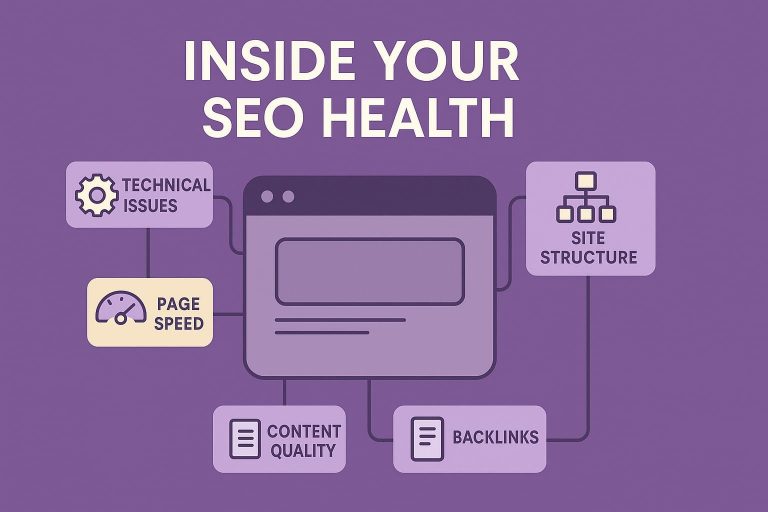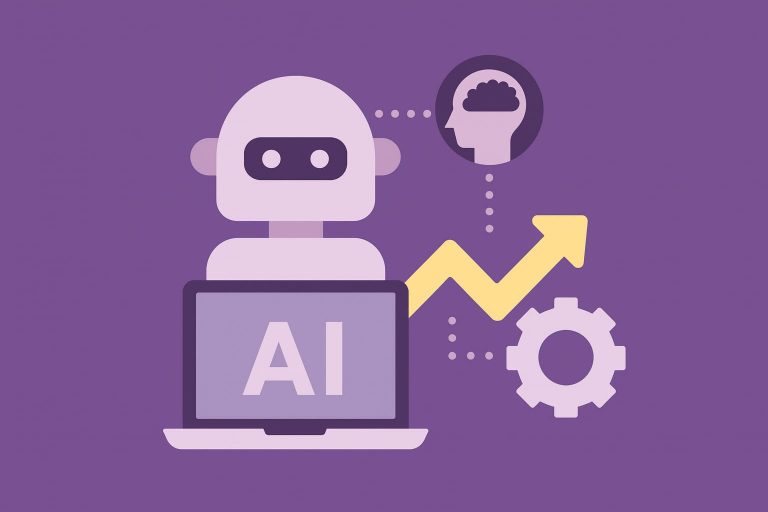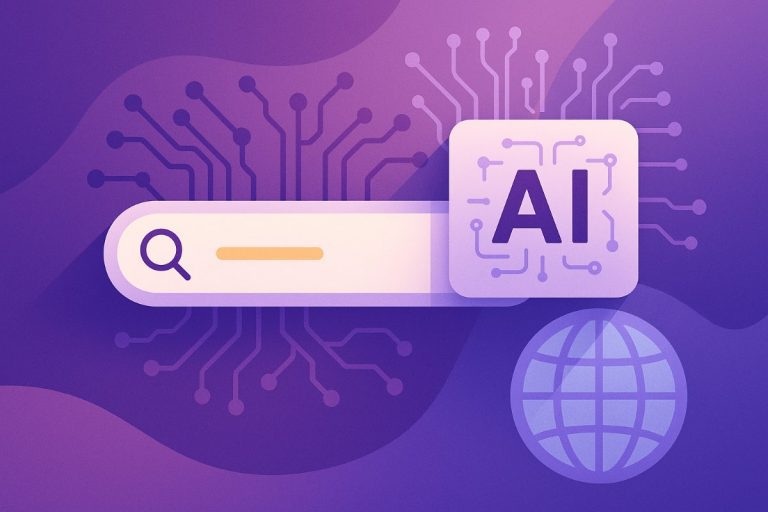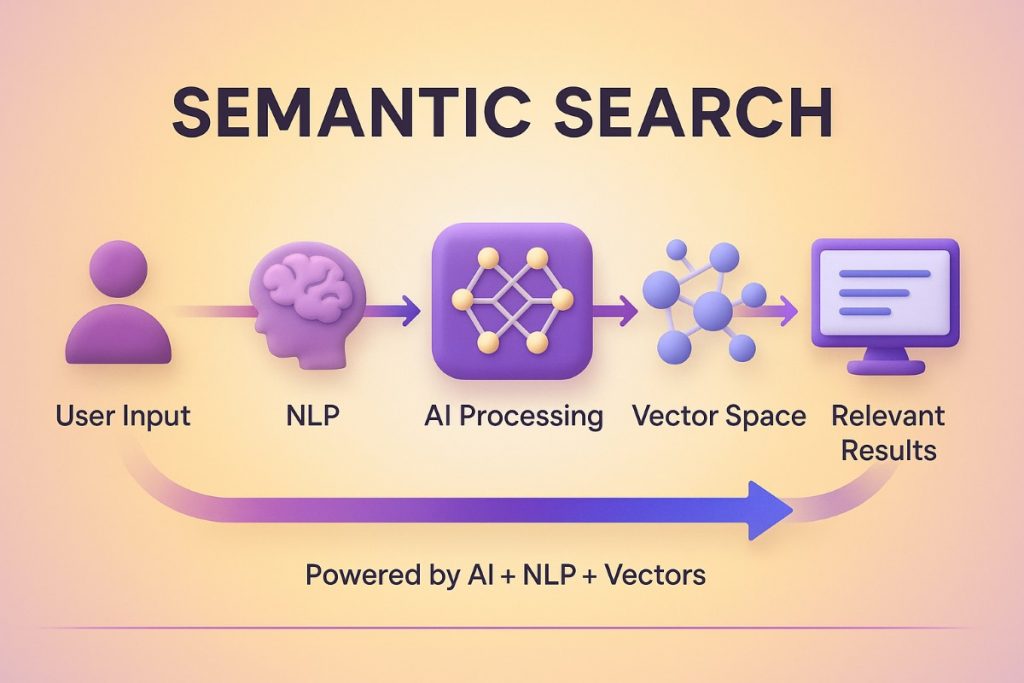
- What is Semantic Search?
- The Evolution From Keywords to Meaning
- Semantic Search vs. Traditional Search Methods
- How Semantic Search Actually Works
- Understanding Search Intent and Context
- Semantic Search Examples in Action
- Leveraging Semantic Search for Digital Marketing Success
- E-commerce Search Applications
- Implementing Semantic Search Strategies
- The Future of Semantic Search
- Conclusion: Embracing the Semantic Web
- Frequently Asked Questions
Semantic search represents the next stage in the evolution of digital information retrieval. By combining AI-powered algorithms, machine learning, and vector technology, it enables search engines to understand meaning, context, and intent — delivering results that are more accurate, relevant, and human-like than ever before.
What is Semantic Search?
Semantic search is an advanced search technology that interprets the meaning behind words, rather than relying on exact keyword matches. Unlike traditional search methods that focus on literal terms, meaning-based search uses machine learning and artificial intelligence to understand context, user intent, and relationships between concepts. This shift represents a major step in search evolution, enabling systems like Google Cloud Vertex AI Search, BigQuery, and AppSheet to deliver more accurate and relevant results. By understanding semantics, modern search engines can connect users with the information they truly seek, improving both precision and overall search experience.
Key Takeaways:
- Semantic search focuses on meaning, not just keyword matching.
- AI and machine learning drive contextual understanding.
- It powers smarter, more relevant search experiences.
- Core examples include Google Cloud’s Vertex AI Search and related technologies.
The Evolution From Keywords to Meaning
The search evolution reflects a fundamental transformation in how information is retrieved and ranked online. Early keyword search systems matched exact terms, often ignoring context or intent. As search algorithms advanced with machine learning and artificial intelligence, engines like Google began to interpret the semantic search meaning — understanding what users want, not just what they type. This progress improved the accuracy, relevance, and personalization of results. For users, it means faster access to meaningful information; for content creators, it requires producing context-rich, intent-oriented content.
Semantic Search vs. Traditional Search Methods
Understanding the difference between semantic search and traditional search approaches is essential for evaluating how modern information systems interpret user queries. In keyword and lexical search, engines rely on literal word matching, which limits their ability to grasp meaning or intent. By contrast, semantic search analyzes relationships between words and concepts, while vector search represents meanings mathematically to improve contextual accuracy. In this search comparison, semantic models consistently outperform others in relevance, adaptability, and user satisfaction, although they require more advanced infrastructure and data processing.
| Search Method | Accuracy | Context Understanding | Implementation Complexity | Typical Use Cases |
|---|---|---|---|---|
| Traditional Keyword Search | Low – relies on exact matches | None | Low | Basic website or document search |
| Lexical Search | Moderate – includes variations and word forms | Limited | Moderate | Text-based search engines, dictionaries |
| Vector Search | High – captures semantic similarity | Strong | High | Recommendation systems, AI-driven search |
| Semantic Search | Very high – interprets meaning and intent | Advanced | High | Intelligent search engines, enterprise solutions |
The Problem With Keyword-Only Search
Traditional search engines based solely on keywords often lead to search frustrations due to their rigid dependence on exact match terms. These systems fail to recognize synonym issues and variations in phrasing, causing users to miss relevant information. The keyword limitations become evident when a query like “affordable flights” doesn’t return results for “cheap airfares”. This narrow matching approach overlooks context and user intent, resulting in irrelevant results and a poor overall search experience, particularly for complex or nuanced topics.
How Semantic Search Solves These Issues
Semantic search overcomes these challenges by focusing on context understanding and query intent rather than literal words. Through machine learning and natural language models, it identifies the relationships between terms and interprets what the user truly means. This results in greater search relevance and a more intuitive experience. For example, a semantic system links “affordable flights” with “cheap airfares”, improving coverage and precision. The semantic search benefits extend beyond accuracy — users spend less time reformulating queries, and businesses see higher satisfaction rates and engagement metrics.
Keyword Search vs. Semantic Search
The main distinction between keyword search and semantic search lies in interpretation. Keyword-based systems depend on exact matches, while meaning-based search engines analyze intent and relationships between words. In practice, shifting from keyword to semantic search leads to more comprehensive, contextually relevant results that align better with how users naturally phrase queries.
Lexical Search vs. Semantic Search
Lexical search focuses on literal word matching and word forms, limiting its ability to grasp nuance or concept-level relationships. In contrast, semantic understanding enables systems to process synonyms, related terms, and context. While lexical search performs well for structured text retrieval, semantic search delivers more accurate and adaptable results in dynamic, meaning-rich environments.
Contextual Search vs. Semantic Search
Contextual search and semantic search both enhance relevance but operate differently. The first focuses on user context, preferences, and location to refine results, while the second interprets linguistic meaning and relationships between concepts. Together, they can provide contextual search results that are both personalized and semantically accurate, improving precision across diverse use cases.
How Semantic Search Actually Works
A semantic search engine functions by interpreting the intent and contextual meaning of a query through a combination of machine learning, natural language processing (NLP), and advanced search algorithms. Instead of matching literal words, it transforms both queries and documents into numerical representations — vectors — that capture semantic relationships. These vectors are compared in multidimensional space to identify the most contextually relevant results. The process involves stages such as language parsing, entity recognition, intent classification, and result ranking. Technologies like Google Cloud integrate these components to deliver highly accurate and intuitive search outcomes. This synergy of algorithms and AI models enables systems to “understand” language similarly to humans.
AI’s Fundamental Role in Semantic Search
Artificial intelligence is the foundation of semantic search AI, enabling systems to move beyond simple keyword recognition toward true search intelligence. Using machine learning algorithms and neural networks, AI models analyze massive datasets to identify patterns, meanings, and relationships between words and concepts. This AI-powered search technology allows search engines to adapt continuously, improving accuracy with every query processed. By mimicking human learning, AI transforms static search systems into dynamic tools capable of understanding intent and delivering increasingly relevant results.
The Role of NLP in Semantic Search
Natural Language Processing (NLP) is the bridge between human communication and machine understanding in natural language processing search systems. It enables algorithms to interpret grammar, syntax, and semantics — turning text into structured data that machines can analyze. Through computational linguistics and machine learning, NLP extracts meaning, identifies entities, and detects relationships between terms. This capability allows search engines to recognize nuances such as synonyms, tone, and context, improving the precision of search results. In practice, NLP-powered systems understand user language the way humans do, ensuring that results align with real intent rather than isolated keywords.
Interpreting Natural Language in Search
In natural language interpretation, semantic search systems analyze queries much like humans interpret conversation. By applying language analysis techniques and AI-driven models, they identify meaning behind complex, conversational queries such as “best laptop for designers”. Instead of focusing on individual words, these systems assess context, user intent, and related topics to deliver accurate results. This capability drives the rise of conversational search, where engines understand queries phrased in natural speech, even when terms are ambiguous or incomplete, greatly enhancing user experience and relevance.
Vector Search and Embeddings
Vector-based search converts text into high-dimensional mathematical representations called embeddings, allowing systems to compare meaning rather than exact words. This approach powers vector search vs semantic search solutions, including Elasticsearch vector search and other advanced frameworks. By mapping words, phrases, and documents into vector space, the engine measures semantic closeness — grouping related terms and ideas together. The result is improved contextual accuracy and faster retrieval of relevant content. Embeddings form the backbone of many modern vector-based search systems, driving innovations in recommendation engines and intelligent content discovery.
Understanding Search Intent and Context
Effective search intent understanding is central to delivering relevant results. Every query falls into one of four categories: informational searches (seeking knowledge), navigational searches (looking for a specific website or page), commercial intent (researching before purchase), and transactional searches (ready to act or buy). A semantic search system identifies the intent type behind each query and adapts the results accordingly. This approach ensures users receive not only accurate but purpose-driven information, aligning content delivery with their goals and improving overall engagement and satisfaction.
The Role of Context in Search Results
Search context adds another dimension to result accuracy by considering factors such as location, device type, time, and search history. These inputs help produce contextual search results that match user needs more precisely. By enhancing contextual relevance, semantic systems can personalize experiences without relying solely on keywords. For instance, a query for “restaurants near me” uses the user’s search environment and geography to refine results. The challenge lies in maintaining personalization while protecting privacy, a balance critical to user trust.
Knowledge Graphs and Semantic Networks
Knowledge graphs and semantic networks enable search engines to represent and connect data through structured relationships between entities. In knowledge graph search, information is organized around concepts — people, places, products — and their interconnections, rather than isolated terms. This model supports entity recognition search, improving accuracy by understanding how subjects relate. For example, linking “Tesla”, “Elon Musk”, and “electric vehicles” allows engines to deliver comprehensive, context-rich answers. Such systems enhance precision and depth, driving more meaningful search experiences across industries and applications.
Semantic Search Examples in Action
The impact of semantic searching is evident across multiple industries, from e-commerce to digital marketing and enterprise systems. Real-world semantic search examples show how understanding meaning and context enhances user engagement and satisfaction. In practical applications, these systems help users find accurate, intent-based results faster, reducing frustration and improving efficiency. Each search use case — from website optimization to customer support — demonstrates how meaning-driven search technology transforms user experiences, driving measurable performance improvements and helping organizations deliver more intelligent and responsive digital interactions.
Semantic Search for SEO
The rise of semantic search has reshaped SEO practices, moving the focus from exact keywords to topic relevance and search intent understanding. Modern strategies emphasize semantic keyword research and content optimization that aligns with how users naturally phrase queries. Instead of targeting single terms, successful SEO now builds around clusters of related topics and entities. These SEO implications have led content creators to prioritize depth, context, and user value over keyword density. As Google continues refining its algorithms, brands that integrate semantic principles into their content frameworks consistently achieve stronger visibility and engagement.
Enterprise Applications of Semantic Search
Within organizations, enterprise search powered by semantic technology enhances knowledge management and customer experience. It enables employees to find precise information across large datasets and helps businesses deliver contextually relevant results to users. In real-world business applications, semantic systems have improved response accuracy in customer support, reduced search times in internal databases, and optimized decision-making processes. By connecting data meaningfully, enterprises gain faster insights, improved productivity, and measurable ROI growth. As semantic models evolve, they are becoming a cornerstone of digital transformation and intelligent information management across industries.
Leveraging Semantic Search for Digital Marketing Success
Modern agencies use semantic search implementation as the foundation of effective digital marketing strategies. By integrating meaning-based optimization into enterprise SEO, they ensure that content aligns with how search engines interpret intent and context. Data-driven teams combine technical SEO, structured content creation, and topic clustering to improve visibility and conversions. Understanding user intent and crafting content that reflects real search behavior drive measurable results across industries.
LeadCraft apply these principles in large-scale search optimization projects, consistently delivering performance growth — over 50,000 monthly leads and more than 120 successful enterprise campaigns worldwide.
E-commerce Search Applications
In e-commerce search, semantic technology is transforming how users interact with online stores. By understanding intent rather than relying on exact keyword matches, semantic systems enhance product discovery and streamline the shopping experience. This approach enables customers to find relevant items faster — even when using vague or conversational queries. Retailers leveraging semantic models have reported measurable gains in conversion optimization, including higher engagement rates, improved product relevance, and notable increases in average order value due to more intuitive and accurate search results.
Content Discovery and Recommendation Systems
Semantic search also drives content discovery and recommendation engines across digital platforms. By applying semantic matching, these systems identify relationships between user interests and available content, creating truly personalized content experiences. Instead of recommending based on clicks alone, semantic algorithms interpret meaning, context, and behavior to surface relevant materials. This balance between algorithmic precision and user choice results in higher engagement, better retention, and more satisfying browsing experiences across streaming, news, and educational platforms.
Implementing Semantic Search Strategies
Successful semantic search implementation requires a balanced focus on both technology and content strategy. The goal is to enhance user experience through meaningful, intent-driven search optimization. Below is a step-by-step framework used to integrate semantic search effectively across websites and applications:
| Action Stage | Key Activities & Objectives |
|---|---|
| Audit Existing Search Systems | Identify keyword-based limitations and define measurable improvement goals. |
| Develop Semantic Architecture | Implement AI-driven algorithms and embeddings to interpret context and intent. |
| Enrich Content with Entities | Structure data and integrate schema markup to enhance machine readability. |
| Train Models with Real Queries | Use anonymized search data to fine-tune accuracy and personalization. |
| Monitor and Optimize Continuously | Analyze user behavior, refine ranking models, and adjust strategy for ongoing improvements. |
Optimizing Content for Semantic Understanding
Effective content optimization for semantic SEO requires aligning language, structure, and context. This involves using topic modeling to group related ideas, applying entity recognition search to highlight key concepts, and integrating semantic keywords naturally. Well-structured, context-rich content signals relevance to search engines, improving visibility and engagement across semantic environments.
Technical Implementation Considerations
When planning semantic search definition and deployment, teams must address implementation challenges like search architecture design and technology selection. Choosing scalable AI and machine learning frameworks ensures that the system adapts to growing datasets, evolving user behavior, and new contextual patterns, maintaining high accuracy and performance over time.
The Future of Semantic Search
The future of semantic search is defined by rapid AI advancements and the evolution of machine learning models that enable systems to interpret information more intuitively. Emerging search trends point toward a shift from keyword dependency to fully context-aware, next-generation search that understands tone, intent, and even emotion. As generative AI integrates with semantic frameworks, search will evolve into a conversational, predictive experience — anticipating user needs before queries are completed. These innovations will reshape how users interact with digital information, creating more intelligent, adaptive, and personalized search ecosystems across every industry.
Conclusion: Embracing the Semantic Web
The rise of semantic web technology marks a pivotal shift in how information is processed, connected, and understood across the digital landscape. By moving beyond keywords, semantic systems enable more meaningful information retrieval, aligning results with real human intent. This evolution drives digital transformation, empowering businesses to create smarter, more intuitive user experiences. As AI and machine learning continue to advance, the importance of semantic search will only grow — redefining how data interacts. To stay ahead, organizations should partner with professionals who understand and implement these evolving principles effectively.
Frequently Asked Questions
What is semantic search?
Semantic search is an advanced search approach that focuses on understanding the meaning and intent behind a query, rather than matching exact keywords. It delivers more accurate and contextually relevant results based on user needs.
How does semantic search work?
Semantic search uses artificial intelligence, natural language processing, and vector-based models to interpret relationships between words and concepts. It processes language similarly to humans, analyzing intent and context to improve search relevance.
What is the difference between text search and semantic search?
Traditional text search relies on keyword matching, while semantic search interprets meaning and relationships. This allows semantic systems to understand user intent and provide richer, more accurate responses.
What are the benefits of semantic search?
Semantic search improves result accuracy, enhances user experience, supports natural language queries, and increases engagement by delivering information that matches intent rather than literal keywords.
What is semantic search with an example?
For example, when a user searches for “affordable flights,” a semantic search engine also returns results for “cheap airfares” or “budget travel options,” recognizing that the phrases share the same intent and meaning.














 334
334  21 min
21 min




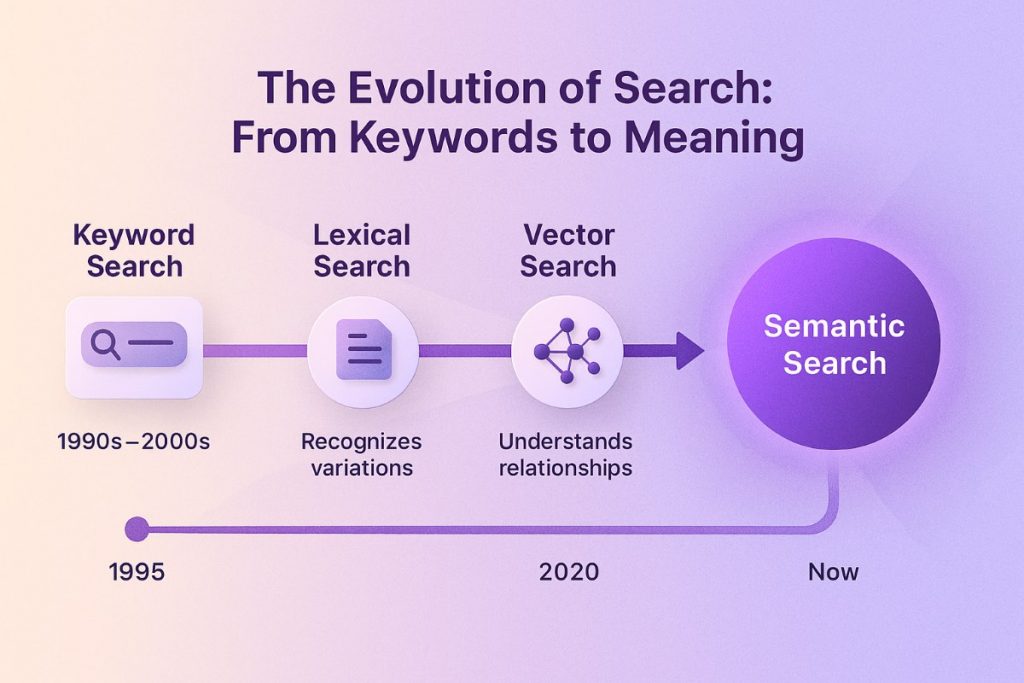
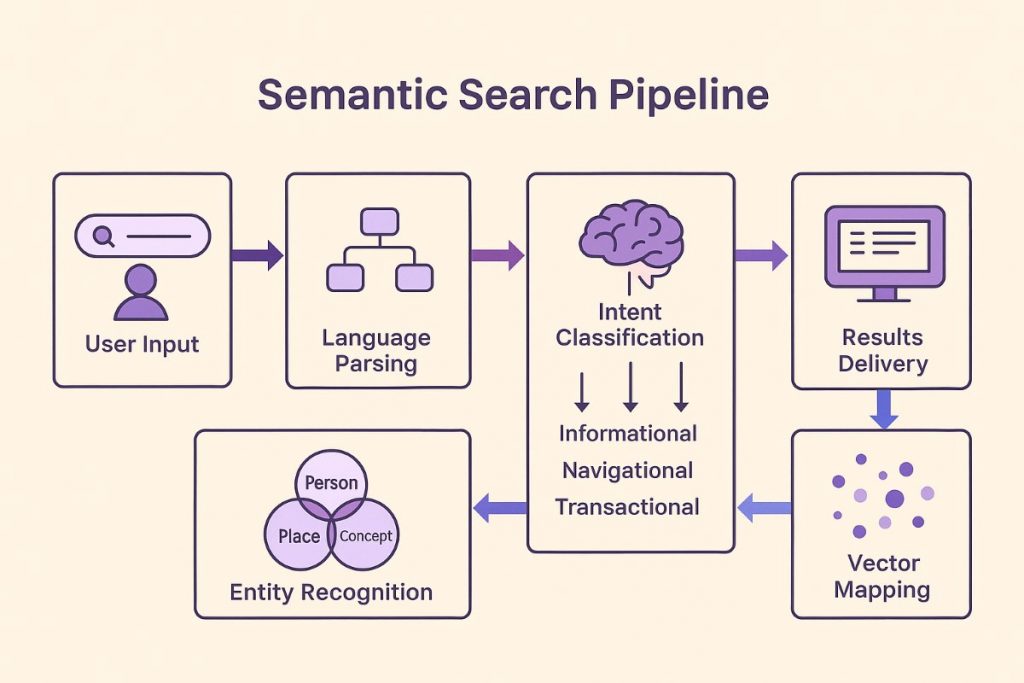
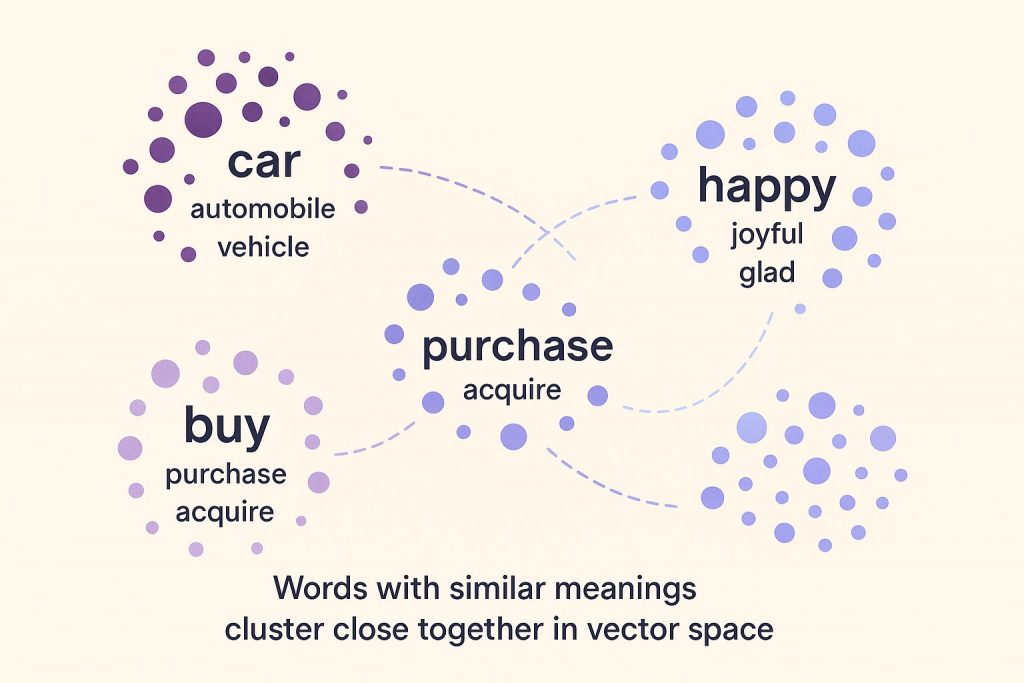
 Share
Share
 X
X
 LinkedIn
LinkedIn













